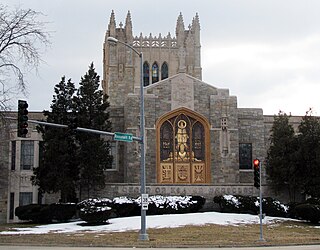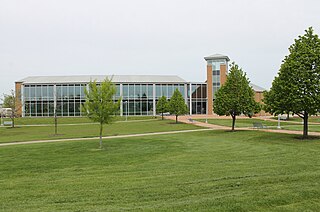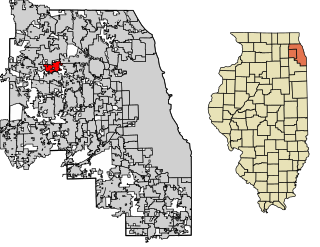
Will County is a county in the northeastern part of the state of Illinois. According to the 2020 census, it had a population of 696,355, an increase of 2.8% from 677,560 in 2010, making it Illinois's fourth-most populous county. The county seat is Joliet. Will County is one of the five collar counties of the Chicago–Naperville–Elgin, IL–IN–WI Metropolitan Statistical Area. The portion of Will County around Joliet uses area codes 815 and 779, while 630 and 331 are for far northern Will County and 708 is for central and eastern Will County.

Bellwood is a village in Proviso Township, Cook County, Illinois, United States. Located 13 miles (21 km) west of Chicago's downtown Loop, the Village of Bellwood is bounded by the Eisenhower Expressway (south), the Proviso yards of the former Chicago & Northwestern, now Union Pacific Railroad (north), and the suburbs of Maywood (east) and Hillside and Berkeley (west). The population was 18,789 at the 2020 census.

Berkeley is a village in Cook County, Illinois, United States. Incorporated in 1924, the population at the 2020 census was 5,338.

Golf is a village in Cook County, Illinois, United States, incorporated in 1928. As of the 2020 census, the village had a population of 514. The community is primarily residential, and has a dedicated police department, post office, and Metra train stop.

Hanover Park is a village in Cook and DuPage counties in the U.S. state of Illinois. A suburb of Chicago, the population was 37,470 at the 2020 census. Ontarioville is a neighborhood within the village.

Hickory Hills is a city in Cook County, Illinois, United States. Located principally in Palos Township, it is a suburb of Chicago. The population in 2020 was 14,505.

Hillside is a village in Cook County, Illinois, United States. As of the 2020 census it had a population of 8,320. It is a suburb of Chicago.

Matteson is a village in Cook County, Illinois, United States. The population was 19,073 at the 2020 census. It is a suburb of Chicago.

Richton Park is a village and south suburb of Chicago in Cook County, Illinois, United States. The population was 12,775 at the 2020 census.

Riverside is a suburban village in Cook County, Illinois, United States. The population of the village was 9,298 at the 2020 census. It is a suburb of Chicago, located roughly 9 miles (14 km) west of downtown Chicago and 2 miles (3 km) outside city limits. A significant portion of the village is in the Riverside Landscape Architecture District, designated a National Historic Landmark in 1970.

Roselle is a suburb of Chicago and is a village located in both DuPage County and Cook in Illinois. Roselle was first incorporated in 1922 as a bedroom community, with its train stop attracting residents commuting to Chicago or nearby suburbs for their jobs. As of the 2020 census, the village's population was 22,897.

Stickney is a village in Cook County, Illinois, United States. Per the 2020 census, the population was 7,110. The village is named for Alpheus Beede Stickney, a railroad executive who played a central role in establishing the Clearing Industrial District. It was well known in the 1920s and early 1930s as the home for several bordellos linked to mobster Al Capone's empire.

Summit is a city in Cook County, Illinois, United States. The population was 11,161 at the 2020 census. The name Summit, in use since 1836, refers to the highest point on the Chicago Portage between the northeast-flowing Chicago River and the southwest-flowing Des Plaines River located just north of the city.

Tinley Park is a village in Cook County, Illinois, United States, and is a suburb of Chicago. Per the 2020 census, the population was 55,971, and it is among the fastest-growing suburbs southwest of Chicago.

Willow Springs is a village in Cook County, Illinois, United States, with a small portion extending into DuPage County. The village was founded in 1892 and was named for the springs along the Des Plaines River. In 2020, the population was 5,857.

Joliet is a city in Will and Kendall counties in the U.S. state of Illinois, 35 miles (56 km) southwest of Chicago. It is the county seat of Will County. It had a population of 150,362 at the 2020 census, making it the third-most populous city in Illinois.

Lockport is a city in Will County, Illinois, United States, located 30 miles southwest of Chicago. Per the 2020 census, the population was 26,094. The city was incorporated in 1853. It is situated along the Illinois and Michigan (I&M) Canal, and was the headquarters of the canal when the canal was operating. A section of the canal runs through Lockport, including the remains of the canal's Lock No. 1 from which the town received its name. The canal right-of-way is now the Illinois and Michigan National Heritage Corridor.

Mokena is a village in Will County, Illinois, United States. It is a southwest suburb of Chicago. The population was 19,887 at the 2020 census. The Census Bureau's 2019 estimate found that the population had increased to 20,159.

New Lenox is a village in central Will County, Illinois, United States. It is a Southwest suburb of Chicago. The village population was 27,214 as of the 2020 census. New Lenox has schools like Lincoln-Way West High School, Providence Catholic High School, and Lincoln-Way Central High School.

Frankfort Township is one of twelve townships in Franklin County, Illinois, USA. As of the 2020 census, its population was 6,443 and it contained 3,256 housing units.


























